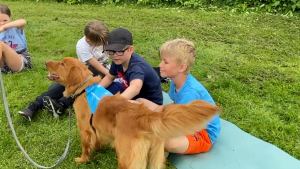Attachment Theory Research
Working with our partners, worldwide veterinary health company, Ceva Animal Health, we have been highlighting fascinating new research into the attachment theory between children and young people and their companion animals.
Many experts agree that companion animals can be beneficial to human wellbeing, and there is considerable anecdotal evidence to support this idea. High-quality, peer-reviewed science in this area is, however, largely lacking. This makes it difficult to develop effective evidence-based policies, best  practices and guidelines for organisations and individuals working in the field of animal-assisted interventions.
practices and guidelines for organisations and individuals working in the field of animal-assisted interventions.
Sound policies and guidance are vital to ensure animal-assisted interventions – ranging from fully-trained assistance animals to family pets – respect the well-being of both humans and animals, and
deliver maximum benefits. A sound evidence base is also crucial if public health agencies and other organisations are to be convinced to allocate scarce resources to animal-assisted interventions over other options.
As part of its ongoing support to the International Association of Human-Animal Interaction Organizations (IAHAIO), Ceva is continuing to support innovative research to help enhance the science around the human-animal bond. It particularly focuses on how pets can improve the wellbeing  of children and young people, including those living with mental health challenges. Earlier support from Ceva helped to shed light on a mechanism (synchrony 1) that may underlie the effect of dog-assisted therapy and how this makes a difference for children with autism spectrum disorder and Down syndrome 2.
of children and young people, including those living with mental health challenges. Earlier support from Ceva helped to shed light on a mechanism (synchrony 1) that may underlie the effect of dog-assisted therapy and how this makes a difference for children with autism spectrum disorder and Down syndrome 2.
The latest PhD researcher to be supported by Ceva is Danielle Groenewoud, an experienced clinical psychologist, who is comparing the nature of the bond between youngsters aged 8-14 years with their pets and also with their parents. In her clinical work with adolescents with depression or anxiety, Danielle is used to working with the whole family – parents and siblings, and often pets too. She realised, however, that 20-years ago, when she trained, there was nothing in the curriculum about the human animal bond and, even now, this topic receives only scant coverage.



